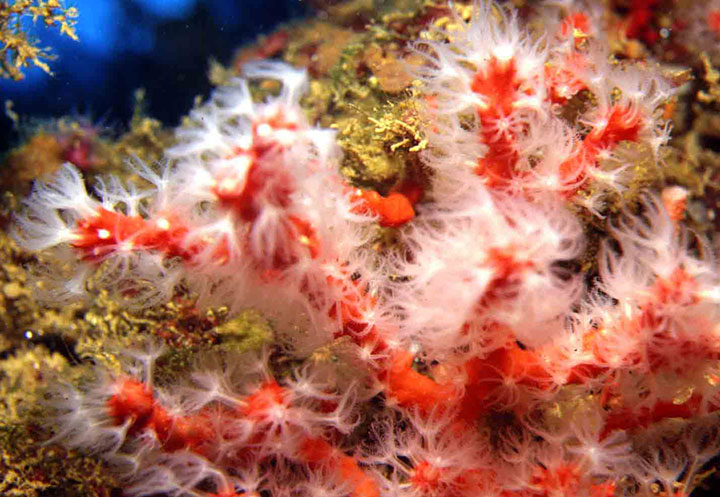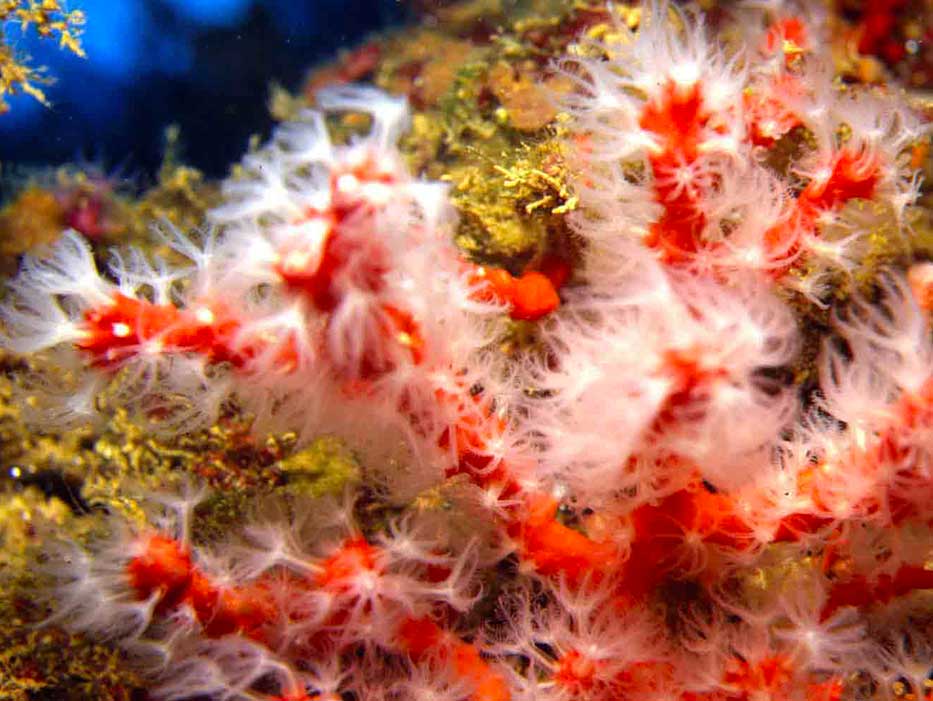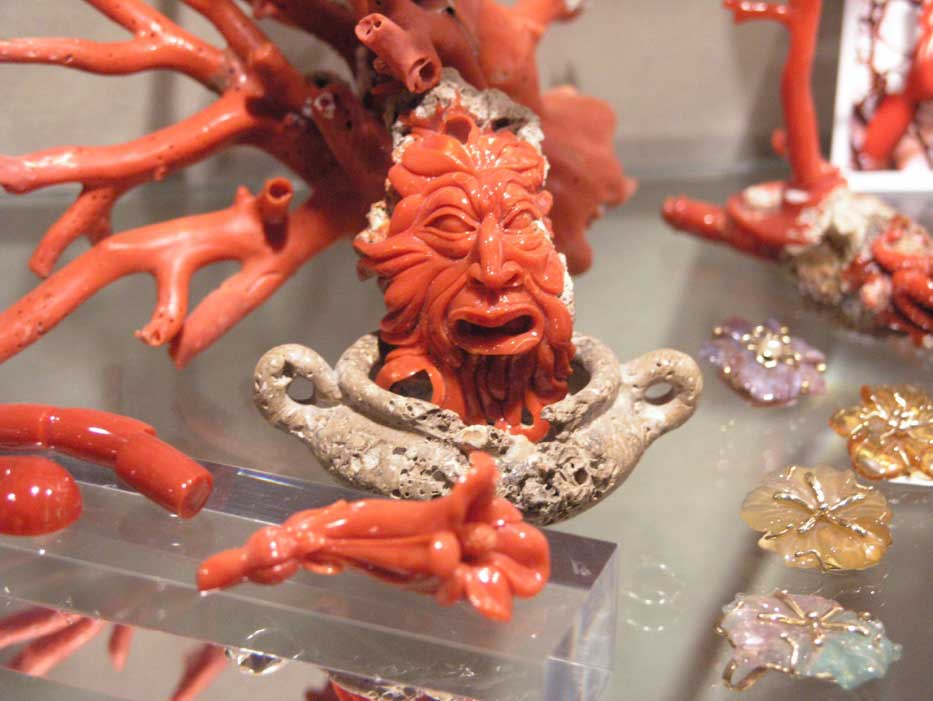
Red Coral, biology, history and curiosities of an animal with a legendary charm.
The name “Riviera del corallo” is not accidental for the Alghero coast where Sealives offers its sea excursions. Everyone certainly knows it by sight but perhaps not everyone knows that coral is a living being. In fact, it belongs to the animal kingdom and is the only species of the Corallium genus that lives in the Mediterranean Sea.
It forms ramified colonies, which can exceed 20-30 cm in height, generally bright red, but sometimes pink. The very hard calcareous skeleton is covered by a layer of soft tissue called coenosarco.
Inside, the skeleton has a network of canals very similar to the circulatory system.
Not only that, all the parts of the skeleton are fed through this system of channels, but the information is passed on to the whole colony of octopuses that are inside. The polyps are white and transparent, only a few millimeters long, with eight tentacles edged with pinnate appendages, visible when these are everted to catch food.
If we try to touch a single polyp, even a peripheral one, this, recognizing a state of danger, contracts inside its cavity hiding itself completely from view and so will all the polyps in the colony: a sign that the information immediately filters from one polyp to another. ‘other. Therefore we cannot think of a series of octopuses that live an independent life even if in a colony, we must instead see the octopuses as the mouths through which the coral feeds and maintains contact with the outside world.
Corallo needs particular living conditions: constant water salinity, reduced water movement and attenuated lighting, therefore it lives preferably in shady and sheltered places such as semi-dark caves, overhangs, rock crevices, starting from a depth of 20/ 30 meters up to 200 meters. It has a growth of about 3-4 cm per year in height and 0.25-0.60 mm per year in diameter.
Coral carries with it more than 30,000 years of history. Testimonies of its use come to us through Neolithic tombs or among the jewels of a Sumerian goddess (4000 BC), from ancient Iran to Greek mythology (where it was thought to be the blood gushing from the petrified head of the Medusa), and again Pliny the Elder he counts it as a remedy for various ills; up to 1599, where in the Treaty of the Sea Ferrante Imparato decides (wrongly) that the vegetable nature of the coral is clear.
There were many (philosophers, poets, doctors, naturalists) who expressed their opinion on the subject, yet already in 1600 the Neapolitan alchemist Filippo Finella had affirmed with convincing evidence that that plant or stone was instead an animal. However, no one listened to him until after a century, in 1723, the Frenchman Jean Atonie Peyssonnel, a doctor from Marseilles, announced that this controversial little tree was an animal, indeed a colony of animals!
But this statement will be categorically rejected by the scholars of the time for a few more decades, and poor Peyssonnel was considered a madman.
We will have to wait until 1864 to admire the most complete and consulted work, it belongs to the French researcher Henri Lacaze-Duthiers, even if it is necessary to mention, without diminishing his well-deserved fame, the researcher Filippo Cavolini, of the University of Naples, the which had published in 1683 his Memoirs to serve the history of marine polyps, a careful study of the anatomy of coral polyps.
Over the centuries, coral has been the subject of numerous superstitions. Since red is the color of blood, the meaning of life itself was associated with this color, as if without that “red” there could be no life; and always that instinct suggested wearing something of the same color on one’s body which, if necessary, could replace the other.
Thus it was that man believed he had found protection against death in coral, of which he later also discovered its beauty. It was adapted to the most diverse uses: apotropaic, precious stone, medicine, coin, ornament, aphrodisiac, fertilizer.


In ancient times it was often reduced to powder and mixed with water, so treated it was believed to be able to cure numerous diseases. He was also attributed the power to drive away evil spirits, to instill wisdom, to stop bleeding and to lower fever. A tonic known as “coral tincture” was obtained by heating a branch of coral in molten wax and dipping the concoction in an alcoholic solution. It increased sweating and had a diuretic effect, thus expelling “bad humours” from the body, and always in the past, it was believed that red coral changed color based on the owner’s state of health. In Italy the tradition of coral is centenary, in the XVII-XVIII century the typical bush earrings with matching necklace were considered the bare minimum for a dignified wedding trousseau, in the XVI century the same lawful and severe sumptuary laws for almost all types of jewelry has never restricted the use of the popular coral. Coral amulets are still widespread in our country, as protection from the evil eye, from evil energies, from bad luck and as a cure for sterility.
From the early years of the twentieth century. Alghero has become the capital of coral fishing, following the discovery of the fishing banks by the fishermen of Torre del Greco after the end of the fishing of the “dead banks” of Sciacca.
In the historical archives of the city, the presence of thousands of coral boats in the port during the summer seasons is noted. For centuries these boats carried out the sampling through the ingenious technique, the cross tool equipped with a heavy metal bar to which numerous pieces of net were secured. Due to the particular devastating action of the seabed of this instrument, this technique has been completely prohibited in Sardinia.
To date, coral fishing in Sardinia is allowed only to a limited number of authorized persons who must also comply with a strict regulation such as, for example, the constraint of not being able to take coral at a depth of less than 80 metres.

